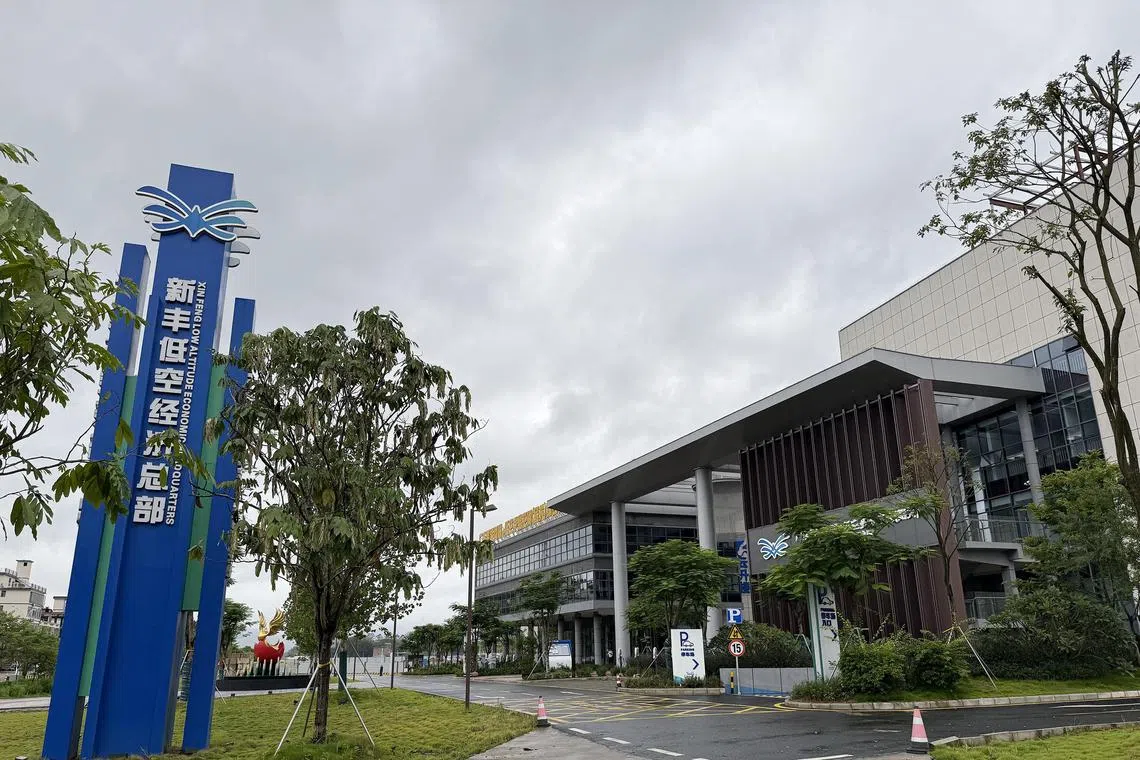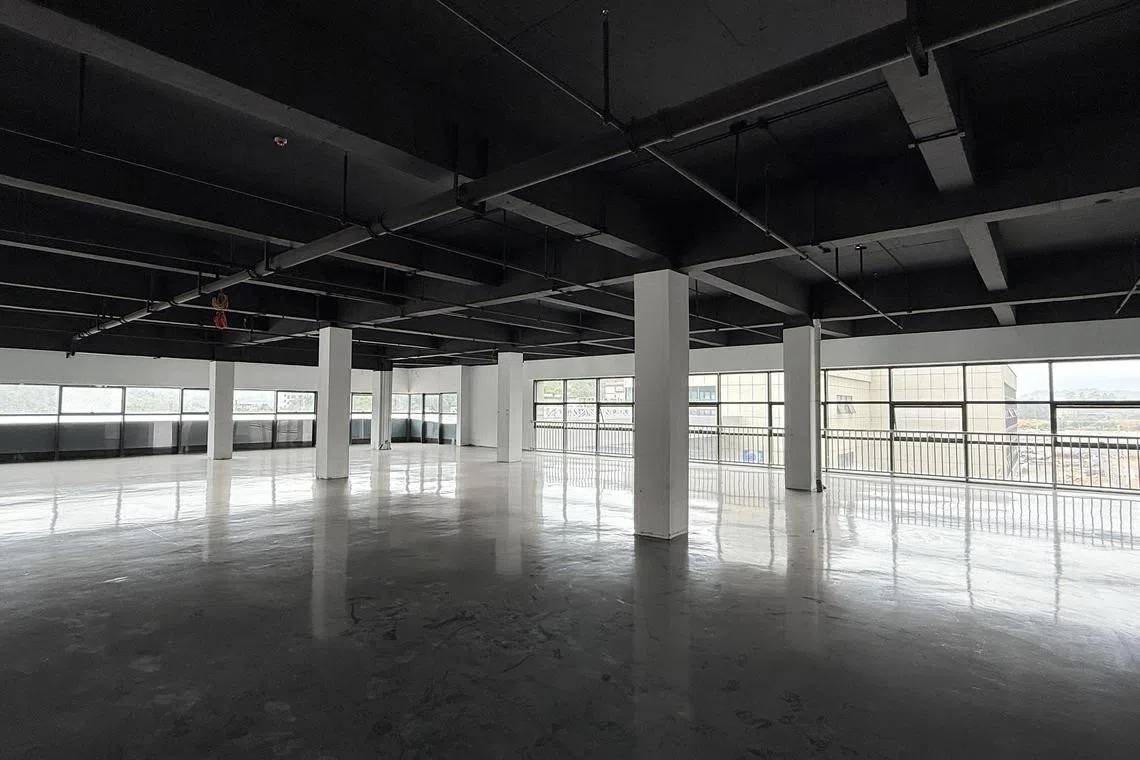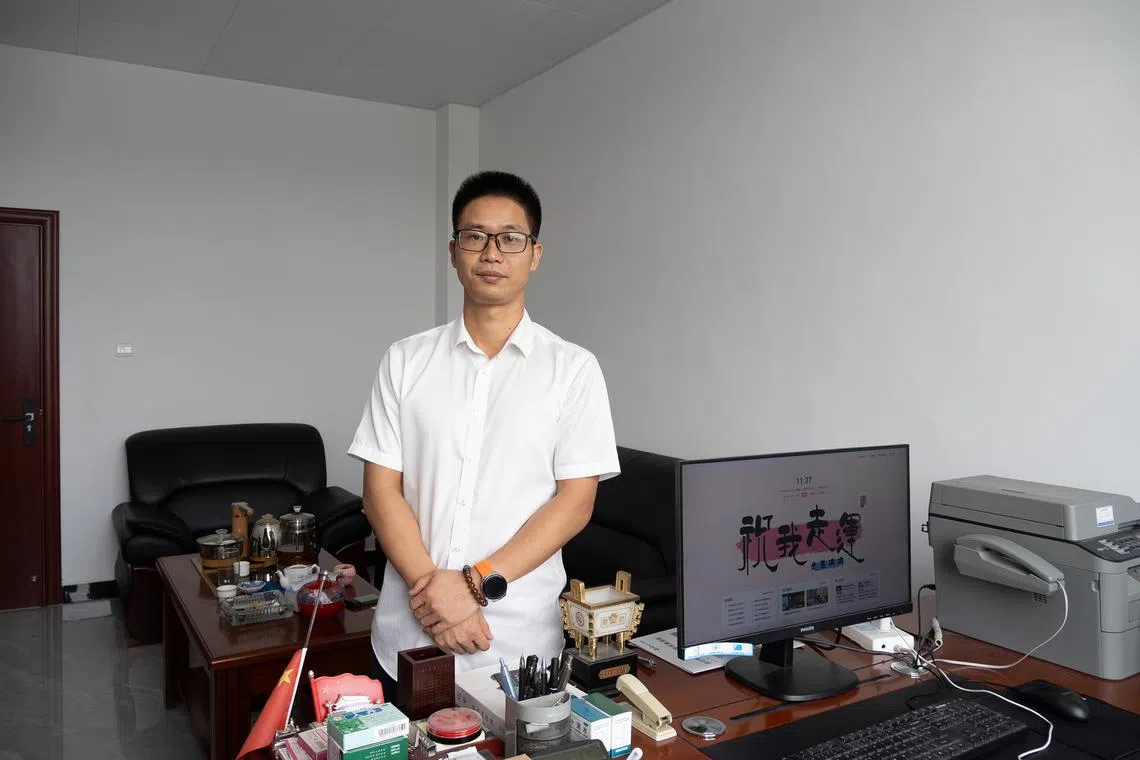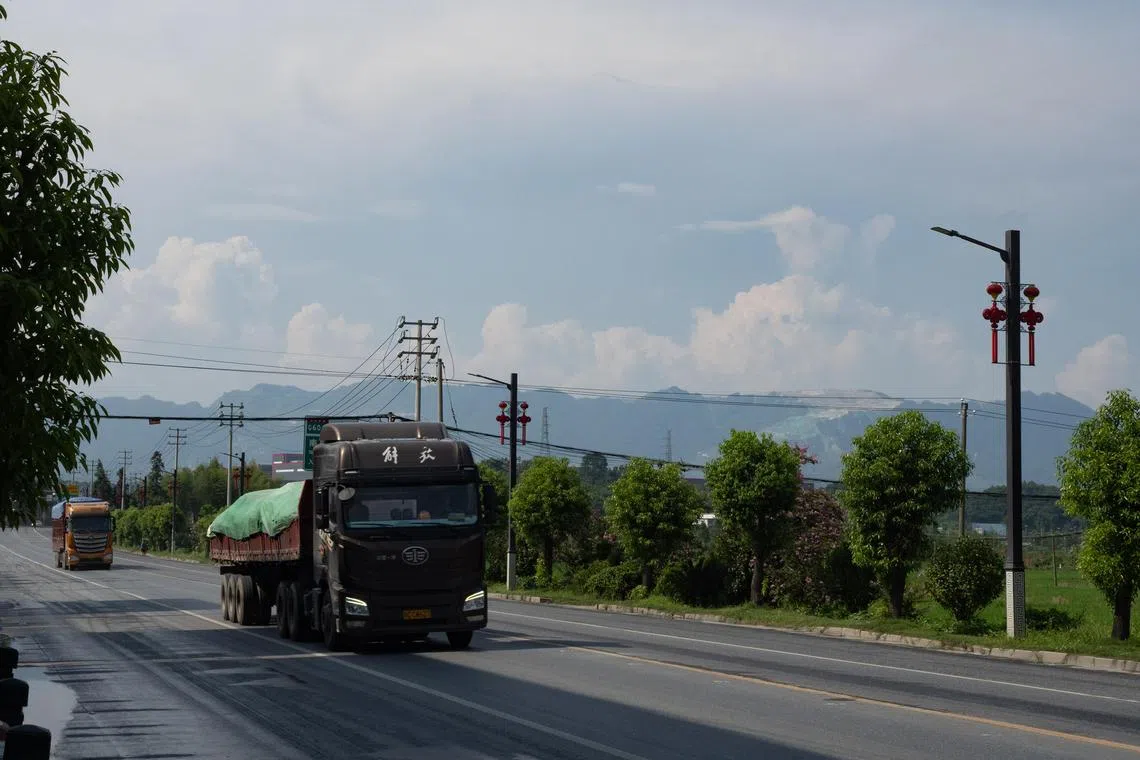Lithium, EVs and now drones: How can China curb wasteful overcompetition?
Sign up now: Get insights on Asia's fast-moving developments

The "Xinfeng Low-Altitude Economy Headquarters", for drone-related companies and activities, opened in the Guangdong county in 2024.
ST PHOTO: JOYCE ZK LIM
Follow topic:
- China's "low-altitude economy," projected at 1.5 trillion yuan, spurs drone industrial parks with incentives, mirroring over-investment seen in EVs.
- Over-competition and local protectionism prompt calls for a "unified national market" and measures to curb unfair practices.
- Experts suggest redesigning local government KPIs, nurturing long-term competitive advantages and protecting intellectual property to tackle overcapacity issues.
AI generated
SHAOGUAN/YICHUN – A small county best known for its mountains and melons is one of dozens of Chinese regions racing for a slice of the booming drone economy.
A gleaming new complex for drone-related companies has emerged down the street from mom-and-pop stores and sleepy homestays in Xinfeng, which has a population of 266,000 and is one of Guangdong province’s less developed counties.
For now, just two drone firms appear to have settled into the complex, which opened in 2024. Several floors in the main five-storey office building stood vacant or were under renovation when The Straits Times visited earlier in August.
But the staff there are not worried. “The businesses will definitely come,” said a deputy general manager of the state-owned company which runs the complex, who asked to be identified only as Mr Chen.
As China ramps up a push to develop its “low-altitude economy”, projected to be worth 1.5 trillion yuan (S$270 billion) in 2025, Xinfeng is just one of at least 45 Chinese localities on a quest to develop drone-related industries, according to a tally by local newspaper The Economic Observer in November 2024.
Industrial parks for drones are being set up around the country. Officials armed with cash incentives are thronging drone expos, wooing companies with generous procurement contracts and rent-free premises. The Xinfeng government, for one, has announced a range of subsidies as well as a 300,000 yuan reward for businesses that can rake in large revenues.
This rush echoes the beginnings of a familiar phenomenon that is now in the authorities’ crosshairs: the over-investment by local governments in sectors favoured by Beijing.
In July, Chinese President Xi Jinping called out the practice of provinces flocking to develop the same few industries, citing artificial intelligence, computing power and new energy vehicles as examples. “Must every province in the country develop industries in these directions?” he asked.
Officials have also reiterated calls for the country to forge a “unified national market”, a long-time aspiration to break down regional protectionist measures, and issued guidelines to this effect in January. The idea is for all firms to compete fairly across China, on a single set of rules, instead of allowing local authorities to practise favouritism that lets less-competitive companies survive.
More concrete measures addressing over-competition are expected in the coming months. China on July 24 released a draft amendment to its pricing law, which would generally bar firms from selling below cost to drive out competitors or monopolise the market.
Fierce domestic competition a way to nurture global winners
For decades, fierce competition between China’s provinces as they pursued overlapping sectors had been a feature of China’s industrial policy, used to nurture firms that are internationally competitive.
A recent report on China’s EV sector by Rhodium Group, a US-based research firm, found that China’s auto subsidies may be contributing to price wars and entrenching “involutionary competition” within the industry. EV powerhouse BYD, for one, has been a key beneficiary of such generous state subsidies.
Over-investment by local governments in sectors favoured by Beijing has led to a proliferation of firms in industries such as EVs, lithium batteries and solar panels. This has caused a surplus of production capacity and cut-throat competition between companies that ultimately end up hurting the economy.
Amid punishing price wars, China’s industrial profits fell by 1.8 per cent year over year in the first half of 2025. Prices of goods leaving factories have been falling for more than two years.
“The drone sector will potentially be another EV sector,” said Dr Yu Hong, an expert on China’s regional economic development at the East Asian Institute in Singapore.
Even as the nationwide rush for drones means China will almost certainly produce more industry champions, he added that “the cut-throat competition means a lot of waste... there will certainly be industrial overcapacity in the drone sector very soon”.
For now though, the Xinfeng government’s play for drones is seen in the county as a ticket to a stronger local economy. Officials cite, among Xinfeng’s advantages, a large stretch of airspace where drone-testing is permitted.

Several floors in the main office building of the Xinfeng Low-Altitude Economy Headquarters were vacant or under renovation when ST visited on Aug 14.
ST PHOTO: JOYCE ZK LIM
Mr Li Jiankao, 36, a local who owns a homestay across the road from the new drone complex, says he hopes that the “low-altitude economy” will help create jobs and drive development in the county.
“If these companies move here, many of our young people won’t need to run to the Pearl River Delta (cities for jobs),” he said.
Overproduction takes place not just across competing cities, but also within individual ones.
Resource-rich Yichun city, in south-eastern Jiangxi province, has had ups and downs in its goal to become the “lithium capital of Asia”. In Yichun, lepidolite is mined as a raw material to extract lithium carbonate, which is then made into lithium batteries and EVs.
The city of 4.9 million people, which has attracted investments from battery giants such as CATL and Gotion High-tech, rode a wave between 2022 and 2023, when lithium carbonate prices surged, as China churned out EVs to the tune of millions of units.
In late 2022, lithium carbonate prices in China surged to a record high of nearly 600,000 yuan per tonne, more than 12 times the price in early 2021. Prices have now stabilised at about 70,000 yuan.
“Even ordinary folks stopped their usual work and were going to the mountains to collect rocks, in the hopes that they would be valuable. That was such a scary phenomenon,” said Mr Liu, the general manager of a lithium processing company, who declined to give his full name.
“In Xinfang Town (a short distance from Yichun), there used to be around 40 to 50 lithium processing companies. Now, only four or five remain,” he said. These processing companies function as sub-contractors for larger companies that own mines.

Mr Liu said it was scary how even ordinary people stopped working and went to the mountains in hopes of finding lithium.
ST PHOTO: LIM MIN ZHANG
Xinfang Town’s “414” lepidolite mine contains rich deposits of lithium, tantalum, niobium, rubidium and caesium. When ST visited on Aug 12, trucks were moving in and out at a steady pace. Yet, this was a far cry from the boom years, local residents told ST.
Moves to curb overproduction are under way.
On Aug 12, the lithium industry branch of the China Nonferrous Metals Industry Association urged companies to take concrete actions to counter “internal competition”. The Securities Times reported that measures to come may involve leading firms initiating production cuts and price hikes.
Mr Liu said that initially, since 2024, the Yichun government had cracked down on businesses that did not comply with regulations or did not have all the necessary paperwork. The remaining businesses had the necessary paperwork but were not profitable, so they closed too.

Trucks operating in a major mining site in Yifeng county, a two-hour drive from Yichun city in Jiangxi province.
ST PHOTO: LIM MIN ZHANG
What can China do to curb excessive competition?
Despite Beijing’s calls to tackle the problem of over-investment and over-competition, experts say this is easier said than done. A key hurdle is the incentive structure for local governments, which are primarily tasked with boosting economic growth in their jurisdictions.
“Everything is about the short term,” said Dr Yu of local officials’ calculus. “(They) need to boost GDP growth, lower the unemployment rate and raise tax revenues.” This means that the authorities are incentivised to nurture and protect local companies – which provide jobs and pay taxes – even if the practice is sub-optimal on a national scale.
To properly tackle nationwide involution, China would need to “fundamentally redesign local governments’ key performance indicators”, he added. This could entail adding metrics measuring progress on dismantling protectionism, for instance, to their assessment criteria.
Associate Professor Gu Qingyang, an expert on the Chinese economy, said the behaviour of local governments and entrepreneurs have both contributed to overcapacity.
Local governments offer low-cost land and preferential tax incentives to try and grow GDP and local champions, while Chinese entrepreneurs often rush to follow investment trends, he said.
“I believe that China’s decision-makers now recognise that this issue has reached a critical stage and requires immediate action,” said Prof Gu, who is from the Lee Kuan Yew School of Public Policy.
Local governments need to improve the way they attract investments – they must not just focus on providing incentives, he said, but nurture longer-term competitive advantages, such as cultivating talent and research and development bases.
“Governments usually focus on the more superficial aspects of attracting foreign investment, while neglecting more important ones, such as protecting intellectual property rights and creating a pleasant living environment,” said Prof Gu.
“They all say, ‘Hey, this is the latest trend, everyone is doing it – data centres, computing power, artificial intelligence’. But do they have a comparative advantage in these areas? If they don’t, can they really succeed in these fields?”

